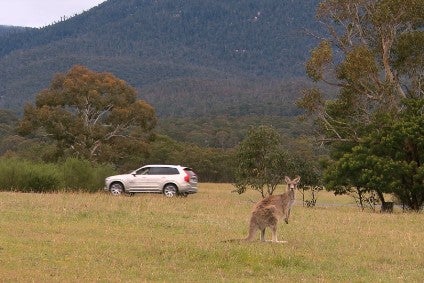
Volvo Cars is finding that kangaroos in mid-jump befuddle the XC90 autonomous drive prototypes it is testing in Australia.
A report carried by the Australian Broadcasting Corporation (ABC) states that the animals’ erratic and unpredictable way of jumping across or along roads confuses the AD cars’ software. The problem stems from the road surface being used as a reference point. This worked in Sweden, where large animals are also a major safety problem but the challenges of Australia are proving unique.
“We’ve noticed with the kangaroo being in mid-flight … when it’s in the air it actually looks like it’s further away, then it lands and it looks closer,” Volvo Australia’s technical manager David Pickett told the broadcaster.
VCC has been testing AD XC90s in the Australian Capital Territory’s Tidbinbilla Nature Reserve since the fourth quarter of 2015. The roos’ hopping continues to present a technical challenge but Volvo believes a technical solution to the issue will be found.
The reserve, which is in Canberra, is the number one spot for the native animals being struck by vehicles. The National Roads and Motorists’ Association says that around 1,000 kangaroos are hit by cars and trucks every year in Tidbinbilla. Nation-wide, the total is close to 16,000.
The ABC’s article goes on to note another issue with AD vehicles and Australia’s unusual conditions. Rita Excell, the executive director of the Australian Driverless Vehicle Initiative, points out that the giant country’s many unsealed roads, multiple unmarked highways, and the vast numbers of so-called ‘road trains’ (truck and trailer combinations which can be as long as 53.5m) all present difficulties for AD software.
How well do you really know your competitors?
Access the most comprehensive Company Profiles on the market, powered by GlobalData. Save hours of research. Gain competitive edge.

Thank you!
Your download email will arrive shortly
Not ready to buy yet? Download a free sample
We are confident about the unique quality of our Company Profiles. However, we want you to make the most beneficial decision for your business, so we offer a free sample that you can download by submitting the below form
By GlobalDataThe technology behind Volvo’s kangaroo detection system is an evolution of City Safety, which is fitted to current production models. This detects cars, cyclists and pedestrians both during the day and night.
A radar sensor in the grille scans the road ahead to detect moving objects such as animals, cars, cyclists and pedestrians. A light-sensitive, high-resolution camera in the windscreen works in parallel with the radar to detect which way the object is moving and help the computer decide what action to take, if any.
When the object is detected, it takes 0.05 second for the computer system to react on the situation. Volvo says the human reaction time is about 1.2 seconds.







